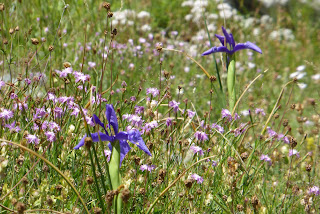Laruns and the Ossau Valley
 |
| Laruns square, with bakery. |
 |
| I do like doorways.... and doors.... specially with wine behind them! |
After a look around the town, and a sustaining coffee (and bun) in Laruns (the boulangerie to the left of the red and yellow awning) we drove on up towards the Col de Portalet. The drive up there was beautiful, stretches of gorge, and areas where the valley opened out more, and we stopped at a dam to find out about it.
 |
| A narrow bit |
 |
| A wider bit at Les Eaux Chaudes |
 |
| Mainly took this because of the rock layers. Well well well, rock comes in layers... OK but they showed up nicely! |
 |
The Fabreges dam - surprising to come across this after miles of gorge and valley
I'd not realised that the river was dammed to create the lake at Artouste |
 |
| Barrage de Fabreges - which holds back a lake by the village of Artouste - there's a train from the village which does a four hour journey up into the mountains but we didn't feel we had quite enough time! |
The "
Petit train d'Artouste" is the highest narrow gauge railway in Europe and looks to be a spectacular ride.
A quick look around the grass below the dam showed some pretty flower - I especially liked the scabious. Seems to be a "blue flower" time of year!
Upper Ossau valley and Col de Portalet
Onward and upward - and I can never resist a picture of some "curly rocks" - I think I first heard them called this in the Pyrenees, on our OUGS trip here in 1996.
 |
| As we climbed above the Lac de Fabreges the valley floor widened |
 |
| Curly rocks |
 |
| More curly rocks |
Finally we reached the col, where we spent a while exploring the tourist tat shops (got a pretty kitchen towel embroidered with alpine flowers) and buying apricots at a fruit stall, before we wandered up the track to see if we could spot the remains of the
Elisita fluorite mine that was active here in the second half of the 20th C.
 |
| Pic du Midi d'Ossau from Col de Portalet |
There were lots of lovely flowers, some pink among the blue this time, alongside the mine track
 |
| A meadow full of little blue iris by the track to Elisita mine. |
There wasn't too much to be seen of the
Elisita mine itself and it was getting rather hot for fossicking around on spoil heaps (not sure we wanted any odds and ends of fluorite anyway!). We'd done what we set out to do which was to see the mine's location and lunch was calling!
 |
| In the right area anyway "Danger, mining area"! |
 |
| Maybe an adit on the right? |
On the way back down to the van I spotted a little lizard who waited long enough to have his picture taken. I think it might be the
endemic Pyrenean Rock Lizard.
 |
| ? Pyrenean rock lizard (Iberolacerta bonnali ) |
The views from here were beautiful! The pass is one of those wide open ones that goes over the lowest bit of the "top" rather than through a narrow defile.
 |
| The view east as we walked back down to the mine track. The col is round the corner on the left and a big skiers car park down in the centre |
Lunchtime and a dolmen diversion
 |
| Plenty of belled cows wandering around the hillsides |
 |
| Where do chairlift seats go in the summer? |
Down the Tena valley
Over to the east we spotted what we thought at first was a couple of big snow patches, though given the hot weather and that we were on the southern side of the mountains, it seemed unusual. A pair of binoculars convinced us that what we could see was (mainly) bands of much paler rock, though there was a little patch of snow at the base of one.
 |
Is that snow on the far peak on the left?
The land in the foreground is the run out from an old landslide. |
 |
| The binocular view - striking contrasts in rock colour, with just a tiny patch of snow, bottom right |
Further on down the Tena Valley we came across a signpost to Santa Elena hermitage and dolmen but, in common with many signposts here there was absolutely no indication of distance... 5 minutes? ... 2 hours? ... so after walking quite a way when we got to a point where the track turned and went steeply downhill we gave up! It was a warm afternoon and we had a campsite to find!
 |
Information board by the track to Santa Elena - as well as the prehistoric dolmen,
there is a hermitage on the site of a cave where Empress Elena of Constantinople took refuge in the 4th century,
and a fortress built by Philip II to defend the frontier against France. |
We stopped overnight just short of Sabinanigo with a long drive in prospect the next day after our day off in the hills!




































What a fascinating record of a lovely drive. Wish I could produce a " diary" like this!
ReplyDeleteI do it rather than writing up a diary - going through photos reminds me of what I've done, and makes the holiday or whatever doubly enjoyable. Maybe you should try it?
Delete